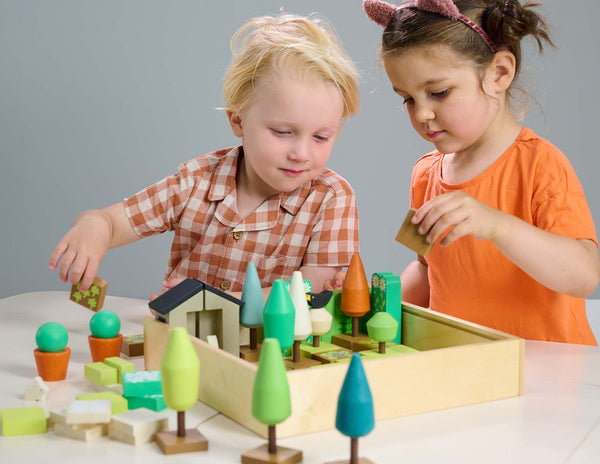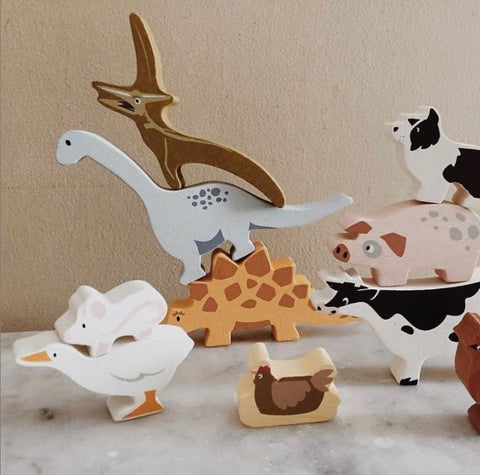How to choose the right toy | Preschoolers

The years before your child starts school are a time of wonder. It’s the time of Father Christmas, the Tooth Fairy - and magic. Above all, it’s a time before reality intrudes, of make-believe and let’s pretend.
The toddler years are behind us. There’s still room for exploration but all the intense experimentation and discovery of heuristic play now makes way for the imagination.
What does that mean for toys?
The best toys for preschoolers
- Wooden railway
- Doll’s house
- Puppet theatre
- Wooden play shop
- Toy kitchen
- Vehicles
- Loose parts
- Peg people
- Wooden animals
- Small world toys
- Tinker trays
Wooden railway
A wooden railway set often becomes a focal point in the play area, offering more than just entertainment. As trains follow the same track repeatedly, it might seem mundane to an adult observer, but it holds a different value for preschoolers.
Children are drawn to understanding spatial relationships such as over, under, and through, and a wooden railway set is an excellent tool for this. The predictability of the track allows children to engage with fundamental concepts in a controlled environment, making abstract ideas more tangible.
Through play, children push the train into a tunnel, watching it disappear and emerge repeatedly, a process that never grows old for them. They are not just playing; they are learning by observing the consistent outcome of their actions. Lying down to watch the train from a different perspective, or altering the incline to see how it affects speed, introduces basic physics concepts through hands-on experience.
As children become more familiar with the toy, its purpose expands. What was once a simple track can evolve into an elaborate scene, rich with narratives and adventures they concoct. With the addition of wooden figures and repurposed toys from earlier years, such as arches and stackers, a wooden railway set can serve as the foundation for a complex, imaginative world that fosters creativity and cognitive development.
Doll’s houses
Doll's houses stand as classic staples in the realm of preschool play. They serve as miniature stages where language development, emotional growth, and narrative skills flourish, building upon the spatial awareness honed during earlier childhood.
Within the walls of these tiny homes, children mirror the dynamics of daily life, processing and understanding their roles within a family and society. They navigate complex questions: What responsibilities come with being a sibling or a child? What are the consequences of certain behaviors?
Through imaginative play, a child may explore scenarios that test boundaries, creating characters that act out bold actions they wouldn't consider in real life. They ponder hypothetical situations – what if the bed could tumble downstairs, or the rules were flipped, and standing on the kitchen table was acceptable?
A doll's house is more than a toy; it's a tool that adapts to a child's developmental journey, providing value for years. It can be a solitary retreat for reflective play or a collaborative space where social skills are developed and honed with peers.
To explore the varieties of doll's houses available, one can look into the many options that cater to this enduring form of play.
See doll's houses.
Puppet theatre
A puppet theatre is a timeless addition to the preschool playroom, fostering narrative skills and linguistic development regardless of whether the puppets are store-bought or handmade. The essence of puppetry lies in the storytelling, the dialogue that breathes life into inanimate characters.
Engaging with puppets sharpens a child’s understanding of narrative flow and the nuances of conversation, highlighting the distinctions between a storyteller's descriptive language and the characters' spoken words. It is this playful practice that will become a reservoir of knowledge for children when they begin their formal education, enriching their written expressions and storytelling abilities.
See the Woodland Stores Puppet Theatre.
Play kitchens
At the heart of every child is the desire to mirror the grown-ups in their lives.
Consider the child who yearns to brew coffee just as their parent does, or the one who wishes to bake croissants, mimicking the daily routines they observe. These tasks, mundane to the adult eye, are captivating ventures for the young ones, eager as they are to engage in the adult world.
The solution to safely channel this imitation is a play kitchen. It allows children to explore and enact these everyday adult tasks with fascination and joy.
These play sets might seem to be simple toys, but they're significant in the eyes of children who use them to dive into the basics of domestic life.
And the beauty of a play kitchen is in its versatility. After countless pretend lattes and play-dough pies have been served, the kitchen can morph into a myriad of other imaginative settings—a bustling office, a distant spaceship, or even the school canteen, extending its utility far beyond the initial culinary framework.
To choose the perfect play kitchen for your child's imaginative culinary adventures, there's a feast of options available that cater to every taste.
See play kitchens

Vehicles
Play involving vehicles might seem simple at first glance, with its seemingly repetitive nature and the stereotypical sounds of 'vroom, vroom!' However, the underlying benefits of vehicle play are significant and often underestimated.
The enduring appeal of this type of play can be attributed to 'schemas' – those patterns of behavior through which children explore and express their understanding of the world. Much like the wooden railway, toy vehicles offer children a hands-on opportunity to engage with concepts of movement. Rolling cars over a bridge, beneath a tunnel, or along a path, children are not only enjoying the experience but are also laying the groundwork for complex spatial and mathematical skills.
At this stage, though, children are blissfully unaware of the educational value; they are drawn to vehicle play simply because it is inherently enjoyable and satisfying.
To delve into the world of toy vehicles and extend the learning opportunities they provide, a collection of wooden vehicles awaits discovery.
See wooden vehicles
Loose parts
Loose parts play may very well be the most ancient and fundamental form of play. This type of play is not a modern invention but a timeless pastime—something even our forebears engaged in. Imagine the simplicity of children in eras past, collecting items from nature like pebbles and acorns, sorting them, and creating patterns.
This basic form of play transcends time and develops foundational skills. These small, movable parts can be used for counting, categorizing, establishing patterns, or crafting ephemeral art pieces. The simplicity of these materials belies the complexity of the learning involved, making loose parts play an endlessly adaptable and profoundly educational experience.
The beauty of this type of play lies in its boundless potential, limited only by the imagination.
See My Forest Floor loose parts set.
Peg people
Peg people are a beloved classic in the world of children's toys. While they may initially captivate infants and toddlers who delight in positioning and posting these figures, their allure certainly doesn't fade as children grow older. For preschoolers, peg people become integral characters in the realm of small world play, allowing for a seamless transition into more complex scenarios and narratives.
These unassuming figures are easy to handle and versatile, making them an essential component of imaginative play. They can take on any role, fit into any story, and their simplicity is what makes them a fixture in children's toy collections.
To explore the variety of peg people available and how they can enhance playtime, one can consider the wide array of sets and individual characters on offer.
See peg people.

Wooden animals
Wooden animals hold a place of honour alongside peg people as indispensable elements in a child's toy collection. When selecting these timeless toys, opting for a cohesive set rather than a mismatched assortment can instantly create a self-contained universe ripe for storytelling. This thoughtful selection process lays the groundwork for intricate play narratives, reminiscent of the charming tales spun by Beatrix Potter with her iconic characters—the wily fox, the wise badger, and the adventurous rabbits.
The beauty of wooden animal figures lies in their ability to spark imagination, inviting children to explore relationships, create dialogues, and develop plots with the natural world as their backdrop. These toys become actors in a child's own unfolding drama, providing endless opportunities for creative play.
See wooden animals.

Small world play
Small world play epitomises the art of miniaturisation, where children recreate life's vast complexity on a scale that is uniquely theirs. It's an intricate process of designing a scene and animating it with figures, be they beasts or humans, incorporating vehicles, edifices, and landscapes crafted from everyday materials.
This type of play is more than mere fun; it’s a tool for learning. By using chalk to sketch out settings on sidewalks or tape to outline terrains on floors, children establish a domain for their figurines to interact, providing a narrative and purpose to their play.
The choice of setting—a bustling cityscape doll's house, a far-flung intergalactic space station, a serpentine railway, or a medieval castle—hinges on a child's individual passions and curiosities. Yet, regardless of the theme, the educational outcomes remain constant. Small world play is a playground for developing communication skills, understanding spatial relationships, and fostering creative thinking.
See small world toys.

Sorting and classifying
The act of sorting and classifying objects is not just a playtime activity—it's a foundational skill that benefits children as they transition to school. Enter the tinker tray: an ideal tool for teaching these very concepts. It serves as a physical canvas for children to make sense of the world by categorising the items it holds.
Presented with a variety of compartments, children are naturally inclined to ponder the placement of each object. An acorn may spark a debate—is it more akin to the collection of nuts or should it be grouped with pine cones, or does it deserve a unique spot?
This decision-making process is subtle yet profound. It pushes children to consider attributes such as size, colour, texture, and material, leading to a deep engagement with their surrounding environment.
Through this seemingly simple act of organisation, critical thinking skills are honed.
See tinker trays.
Final word
The preschool years are the high point of play. The exploration and discover of toddlerdom has made way for more sophisticated games of the imagination. Reality has not yet encroached and there is an innocence to children’s play that will soon be lost.
It’s a time to savour and enjoy.









